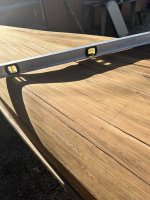Kind of sad to see that. I hope that the damage came from a lot of good times on the water.
Mem might be right here, but I'll play devil's advocate and say that this still might be salvage-able... Depending on some factors.
First: Do you have any info on the canoe? Where/who built, what kind of resin, etc? For example, if this is polyester resin (big-box fiberglass resin) you have first-hand evidence on why most builders now
avoid polyester and prefer epoxy.
Then: Questions about the condition as is:
- Is the interior also delaminated/delaminating. (I might expect a bit of peel-up at the major cracks, but is the glass overall well attached to the interior? If this is a polyester layup, I expect the inside glass to be coming off too. Pics of any spots of concern.
- Is the cedar currently waterlogged, or has it dried out now that the glass is off? This helps evaluate movement.
- Are those gunwales glued on, or fastened? (Fasteners might be visible from the interior.)
I think that these two might be related - the splits opened when the hull bent in. Keep in mind that due to how wood grain works, strip hull cores don't provide much/any strength transversely in the first place. That's entirely up to the glass layup. Structurally, those cracks do not concern me except regarding the potential peel-up on the interior.
Third: What's your goal for this boat, and what is your capability for doing some potentially delicate wood and plastic work? Can you accept that even in the best-case, this canoe will always have scars?


